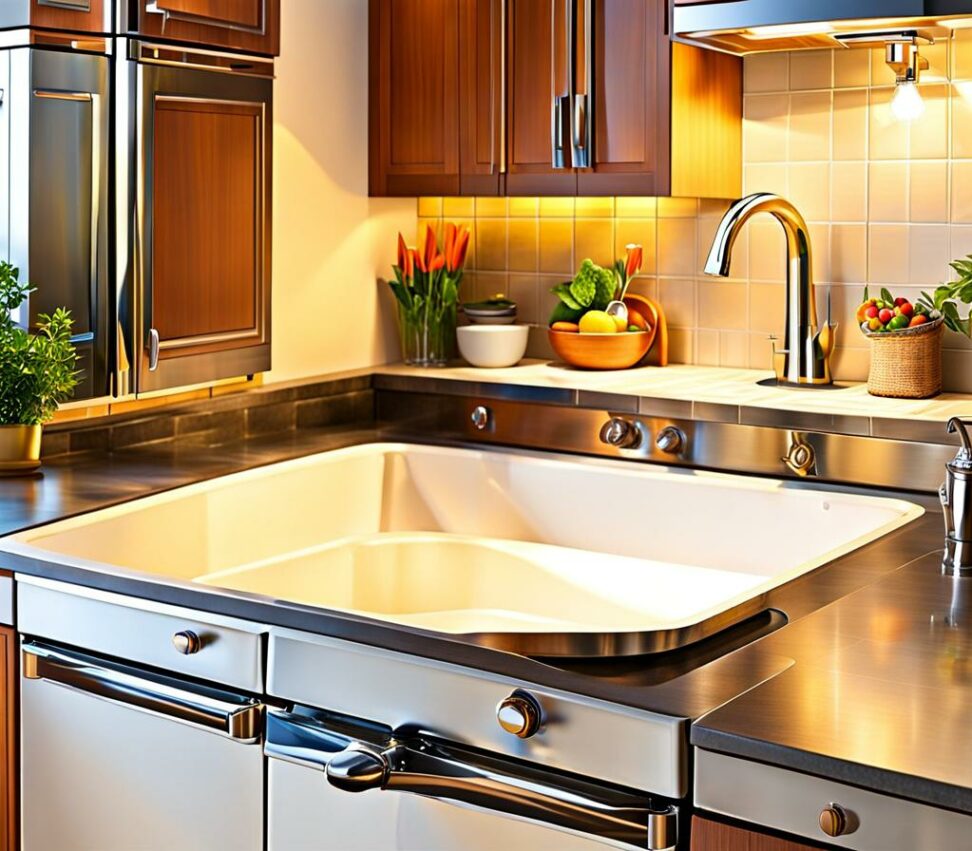Got No Hot Water at the Kitchen Sink? Here's Why and What To Do
Having no hot water flow from your kitchen faucet can be incredibly frustrating. While the rest of your home's taps produce hot water just fine, your kitchen sink only sputters out cold. Low pressure dribbles from the faucet when you want a steaming flow.
This localized loss of hot water is commonly caused by some type of partial blockage or issue specific to that sink's plumbing. The good news is that in many cases, the problem can be diagnosed and repaired yourself without calling a professional.

Symptoms - No Hot Water at Just One Sink
The main indicator is having hot water work perfectly in all other faucets, showers, and tubs in your home, except for the kitchen sink.
You may notice weaker pressure and flow from the kitchen faucet compared to others, even though cold water flows seem unaffected. This points to a hot water specific problem.
What Causes Loss of Hot Water to One Sink?
Clogged or Blocked Faucet/Aerator
Small pieces of sediment, mineral deposits, and other debris can accumulate over time and clog the aerator screen on the tip of the faucet. This restricts water flow through the constricted opening.
Since hot water lines are often more affected by scale buildup, a partially blocked aerator will impede hot water first while cold flows remain steady.
Luckily, removing and cleaning the aerator is an easy DIY fix to restore full pressure.
Shutoff Valves Not Fully Open
Check below your kitchen sink for shutoff valves controlling the hot and cold water lines. If the hot water valve is partially closed, it can reduce flow.
Ensure both hot and cold shutoffs are turned fully counterclockwise to the open position. This will let full water volume through.
Scale Buildup in Pipes
Over many years, mineral deposits from hard water can accumulate inside pipes and restrict flow. Since hot water dissolves minerals faster, the hot water line typically gets blocked first.
Disconnecting and flushing pipes may help, but severe buildup requires a plumber to clear pipes or replace affected sections.
Faulty Faucet/Cartridge
Internal faucet parts like rubber washers and O-rings wear out over time. The cartridge containing these parts can fail to properly regulate hot and cold water.
Replacing an old cartridge with a matching new one can restore single handle faucet function.
Broken Diverter Valve
Diverter valves split water flow between the tub spout and shower head. A broken diverter will block flow to just one side.
If you have no hot water at the tub but do in the shower, a bad diverter is likely the issue.
How to Fix No Hot Water in One Sink
Method 1 - Remove and Clean Aerators
Removing and cleaning the faucet aerator is an easy first step. Turn off hot and cold water shutoffs, then unscrew the aerator at the tip of the faucet spout. Inspect the flow restrictor, screen and other parts for debris. Use a toothbrush or pipe cleaner to scrub and flush the aerator, then reassemble and test.
Method 2 - Flush Pipes and Supply Lines
To clear built up sediment or minerals, disconnect the hot and cold supply lines under the sink. Place each line over a bucket, open the shutoff valves and flush lines one at a time. If flow improves, a partial clog was cleared. Reconnect lines tightly.
Method 3 - Replace Faulty Shutoff Valves
Use a small torch or lighter to check if water leaks past the shutoff valves when closed. If valves fail to shut off fully, replace them. 1/4 turn ball valves offer easier control than antiquated shutoffs.
Method 4 - Swap Out Broken Faucet Cartridges
Removing the faucet handle exposes the interior cartridge. Signs of wear like flat spots on the plastic stem indicate failure. Bring the old cartridge to the hardware store to match a replacement, then swap in the new.
When to Call a Plumber
For severe sediment buildup inside pipes, a professional hydrojetting service may be required. If you can't isolate the issue through DIY troubleshooting, call a plumber. For pipe modifications or re-plumbing work, always hire an expert.
Preventing Future Loss of Hot Water Issues
Regularly removing and cleaning aerators prevents blockages. Annual flushing clears pipes. Replacing washers and O-rings before they fail avoids breakdowns. Water softeners can also minimize harmful scale.
No hot water from a kitchen sink is often caused by an aerator clog, blocked valve, scale deposits, or worn faucet parts. Following the troubleshooting steps above will help diagnose and fix loss of hot water to just one sink in many cases without a plumber.
Check your owner's manual for faucet repair parts and instructions. With some DIY plumbing know-how, you can restore a steady hot water flow to your kitchen.